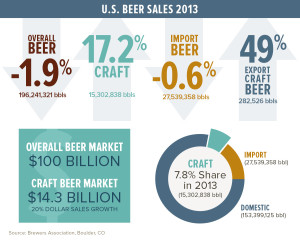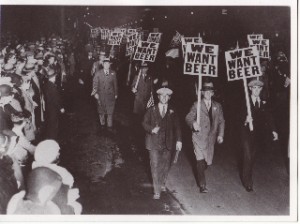
Some of the useful data the U.S. Brewers’ Association releases. Canada has no equivalent organization.
In a pique of stats geekiness the other day I decided to run some numbers on how Canada and the U.S. compare in terms of craft the craft beer scene. And while I was at it, I decided to look at the various Canadian provinces as well.
What I was hoping to do is get past the anecdotes about craft beer scenes and get to some harder numbers. We see lots of talk about how amazing a particular city is (e.g., Portland, Denver, Vancouver) or about a particular region’s reputation (e.g., Quebec). Such praises are unquestioningly deserving and do reveal much about the nature of craft beer culture, if for not other reason than to give the rest of us something to shoot for.
Yet I do find it interesting that we talk so much about the amazing beer scene in Oregon or California or Quebec, but rarely does anyone talk about craft beer in Mississippi, South Dakota or Utah. Similarly Toronto or Montreal get all the love, but we don’t consider our options in Salmon Arm, Peterborough or Antigonish.
I get there is a reason for that. The places where craft beer is succeeding get discussed the most. Yet, there likely is something, at least at some scale, going on craft-beer wise in the other places I mention (for example I picked the three small Canadian cities for a reason – they all have at least one craft beer brewery/brewpub). That is my point. Emphasis on the anecdotes of where craft is strong can distort the full picture.
I am no Nate Silver but I wanted to take a bit of a number-based look at craft beer. There are a number of ways to measure craft beer success: number of breweries, percentage of market, brand recognition, pub culture, etc. I couldn’t look at them all (this isn’t a thesis, for goodness sake!) but decided to focus on two that, at lest theoretically, have some solid grounding in statistics.
The first is the number of craft breweries per capita. This number says a lot about the space in the market for craft beer. Oregon has more than 150 craft breweries. That speaks volumes about the potential to make money brewing beer in that relatively small state. The need to control for population is obvious, I hope.
So, how do Canada and the U.S. compare? The results may surprise you. Canada has more craft breweries per capita than the United States.
| Craft Breweries | Craft per 100,000 population | |
| Canada | 440 | 1.23 |
| U.S. | 2822 | 0.89 |
In both cases the population figure is the most recent census estimate. The U.S. data for brewery numbers comes from the Brewers Association, so they should be pretty solid. The Canadian numbers come from a personal database I have been maintaining for the past few years. I keep track of Canadian brewery openings and closings, using a number of sources, including Canadian Beer News. I don’t promise to have captured every new brewery or bankruptcy (Quebec is a particular weak spot) as my collection method is imperfect. However, if anything I under-estimate the number of breweries in Canada. The list only counts breweries currently operating. By my latest count there are an additional 32 breweries in the planning stages across Canada. I do not know how many breweries-to-be there are in the U.S.
The spread between the two numbers is actually rather staggering. Of course, breweries in Canada will be smaller on average than their American counterparts. We don’t have breweries the size of Samuel Adams and we have a higher proportion of breweries with rather small outputs (no numbers here, just well-grounded logic). Yet Canada has 50% more breweries per capita than the U.S. I personally find that astounding and very, very unexpected.
I also looked at the numbers across the provinces. Again, the numbers might surprise.
| Craft Breweries | Per 100,000 Population | |
| Alberta | 16 | 0.39 |
| B.C. | 100 | 2.16 |
| Saskatchewan | 10 | 0.89 |
| Manitoba | 3 | 0.23 |
| Ontario | 167 | 1.22 |
| Quebec | 106 | 1.29 |
| Nova Scotia | 20 | 2.12 |
| New Brunswick | 12 | 1.59 |
| P.E.I. | 2 | 1.37 |
| Newfoundland | 3 | 0.57 |
| Territories | 1 | 1.71 |
The table suggests three clusters of craft production. Nova Scotia and B.C. are clearly out front with more than 2 per 100,000. A middle group includes Ontario, Quebec, New Brunswick, PEI and the Territories. The laggards are Alberta, Manitoba, Newfoundland, and to a lesser extent Saskatchewan. The flat province may be in the midst of making a jump to the second tier, with its spate of recent openings.
I found somewhat comparable figures for each state compiled by the Brewers’ Association – although they calculate based on population over 21 which would inflate U.S. numbers compared to Canadian. No one comes close to Oregon’s 6.3 and Vermont’s 6.2 breweries per 100,000, yet Canada’s first tier would rank with the top dozen U.S. states, hanging out with the likes of Wisconsin and New Hampshire (2.1 and 2.2, respectively). The second tier would crack the top 25, ranking higher than New York and Pennsylvania (both 1.1). Canada’s bottom dwellers would be in the company of Mississippi (at .2) and Louisiana (.3) at the bottom of the U.S. list.
All in all, on that m etric, Canada holds itself pretty well.
etric, Canada holds itself pretty well.
Yet, number of breweries is only one measure. As acknowledged earlier, Canada’s craft brewers are much smaller than their U.S. counterparts, meaning it is possible craft beer in the U.S. captures a larger percentage of the beer market. Alas, getting a handle on market share is much harder than counting breweries.
The BA indicates that U.S.-based craft breweries make up 7.9% of the beer market. Canadian numbers are much harder to pin down. The national organization that represents the big boys doesn’t offer sufficient detail and there is no other source for national figures.
The Ontario Craft Brewers’ Association reports that Ontario breweries make up 4% of that province’s market. Recently the B.C. Craft Brewers’ Guild was quoted in Yahoo Canada News that craft beer has jumped from 9% of the market in 2009 to a whopping 22% in 2014. Personally I find that number impossible, unless they are reporting sales of ALL craft beer, including imports, which doesn’t really help us (the BA’s numbers suggest this might be what B.C. is doing). Sources tell me they think Alberta’s share is roughly 3%, while Quebec might have the highest share in the country (for linguistic and cultural reasons if nothing else).
So, what are we to make of this mish-mash of numbers? First, at 8% the U.S. craft movement is not as big as their marketing and reputation lead us to believe. Of course, this is an average – places like Oregon rate much, much higher. Second, Canada’s craft scene is not as small as our reputation suggests. It is reasonable to estimate that nationwide craft beer garners somewhere between 3% and 6% of the market. At that level, Canada is smaller, but not much smaller, than our much more revered neighbours.
I may talk more about the provincial comparisons later. But for today it is sufficient to conclude that Canada is surprisingly more robust than anticipated. Both countries have lots of greenfield to cover and both are growing at an impressive rate. Statistics can only tell us so much about how strong a craft beer scene is – so much matters on quality, experience and other intangibles. Either way, both sides have plenty to be proud of.

Leave a Reply